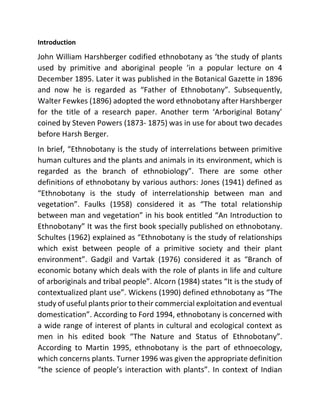
Ethnobotany Lecture.docx
- 1. Introduction John William Harshberger codified ethnobotany as ‘the study of plants used by primitive and aboriginal people ‘in a popular lecture on 4 December 1895. Later it was published in the Botanical Gazette in 1896 and now he is regarded as “Father of Ethnobotany”. Subsequently, Walter Fewkes (1896) adopted the word ethnobotany after Harshberger for the title of a research paper. Another term ‘Arboriginal Botany’ coined by Steven Powers (1873- 1875) was in use for about two decades before Harsh Berger. In brief, “Ethnobotany is the study of interrelations between primitive human cultures and the plants and animals in its environment, which is regarded as the branch of ethnobiology”. There are some other definitions of ethnobotany by various authors: Jones (1941) defined as “Ethnobotany is the study of interrelationship between man and vegetation”. Faulks (1958) considered it as “The total relationship between man and vegetation” in his book entitled “An Introduction to Ethnobotany” It was the first book specially published on ethnobotany. Schultes (1962) explained as “Ethnobotany is the study of relationships which exist between people of a primitive society and their plant environment”. Gadgil and Vartak (1976) considered it as “Branch of economic botany which deals with the role of plants in life and culture of arboriginals and tribal people”. Alcorn (1984) states “It is the study of contextualized plant use”. Wickens (1990) defined ethnobotany as “The study of useful plants prior to their commercial exploitation and eventual domestication”. According to Ford 1994, ethnobotany is concerned with a wide range of interest of plants in cultural and ecological context as men in his edited book “The Nature and Status of Ethnobotany”. According to Martin 1995, ethnobotany is the part of ethnoecology, which concerns plants. Turner 1996 was given the appropriate definition “the science of people’s interaction with plants”. In context of Indian
- 2. ethnobotany the first book published by Jain, S.K., 1981 entitled “Glimpses of Indian Ethnobotany” and Dr. Jain (2001) defined ethnobotany as “It deals with the study of total natural and traditional interrelationship between man and plants and his environment”. In broad terms, ethnobotany is the study of the interrelationship between plants and people. The two major parts of ethnobotany are encapsulated in the word itself ethno: ‘the study of people’ and botany, ‘the study of plants’. However, the field is limited on both sides. On the botanical sides of the field, few ethnobotanical studies are concerned with plants that are not related to the people. On the ethno side, most studies are concerned with the ways indigenous people’s use and view plants. And those uses and views can provide deep insights into the human conditions (Balick and Cox 1996). Ethnobotany represents collective research in botany, archaeology and allied subjects. Ethnobotany requires skillful observations and recording of ecological information through rigorous fieldwork and gathering first hand data. Traditionally, communities have been using various flora for numerous purposes. Scientific documentation of such knowledge is crucial and requires specialized botanical and taxonomic skills. Plants have been associated with human ever since ancient times and their usage may be classified in two groups Cultural and Material 1. Cultural: It includes faith in God or plants taboos, worship and folklores. 2. Material: It includes the material and services provided by the flora such as food, medicine, house construction material, agricultural tools and other domestic uses, plants in painting and carving. Indigenous communities may have their traditional conservation values and practices but current unsustainable-use (such as intensive agriculture, excessive livestock grazing) have led to degradation of the native flora.